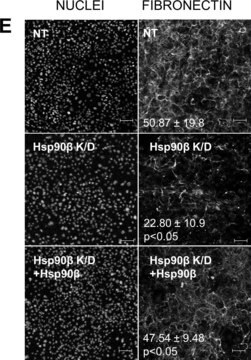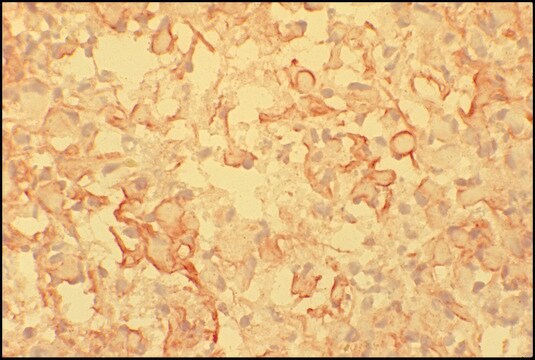推荐产品
生物源
mouse
品質等級
抗體表格
purified from hybridoma cell culture
抗體產品種類
primary antibodies
無性繁殖
FN-15, monoclonal
形狀
buffered aqueous solution
分子量
220-260 kDa
物種活性
human, mouse
濃度
~1 mg/mL
技術
immunoblotting: 0.3-0.6 μg/mL using human fetal fibroblast-like WI-38 cell line extract
immunofluorescence: 2.5-5 μg/mL using human foreskin fibroblast Hs68 cells
immunohistochemistry: suitable
immunoprecipitation (IP): suitable
indirect ELISA: 0.15-0.3 μg/mL using 5 μg/mL Fibronectin from human plasma for coating
同型
IgG1
UniProt登錄號
運輸包裝
dry ice
儲存溫度
−20°C
目標翻譯後修改
unmodified
基因資訊
human ... FN1(2335)
一般說明
Monoclonal Anti-Maltose Binding Protein (MBP) (mouse IgG1 isotype) is derived from the hybridoma MBP-17 produced by the fusion of mouse myeloma cells and splenocytes from BALB/c mice immunized with a purified recombinant MBP fusion protein. Fibronectin (FN), also known as Cold-insoluble globulin (CIG), is a multi-domain glycoprotein composed of two nearly identical disulfide-bound polypeptides. It is widely expressed by multiple cell types and is critically important in vertebrate development, as demonstrated by the early embryonic lethality of mice with targeted inactivation of the FN1 gene 6. In vertebrates, two types of Fibronectin are present: soluble plasma Fibronectin and insoluble cellular Fibronectin. The plasma form of Fibronectin is synthesized by hepatocytes, secreted to blood and, upon tissue injury, is incorporated into fibrin clots to exert effects on platelet function and to mediate hemostasis. Cellular Fibronectin is synthesized by many cell types, including fibroblasts, endothelial cells, chondrocytes, synovial cells and myocytes, it is assembled by cells as they migrate into the clot to reconstitute damaged tissue.
特異性
Anti-Fibronectin antibody, Mouse monoclonal specifically recognizes Fibronectin from plasma and in the pericellular extracellular matrix of cultured fibroblasts from human and mouse origin.
免疫原
Fibronectin isolated from human plasma.
應用
The antibody may be used in various immunochemical techniques including Immunoblotting (∼220-260kDa)1, ELISA, Immunofluorescence, Immunohistochemistry and Immunoprecipitation.
生化/生理作用
The plasma form of Fibronectin is synthesized by hepatocytes, secreted to blood and, upon tissue injury, is incorporated into fibrin clots to exert effects on platelet function and to mediate hemostasis. Cellular Fibronectin is synthesized by many cell types, including fibroblasts, endothelial cells, chondrocytes, synovial cells and myocytes, it is assembled by cells as they migrate into the clot to reconstitute damaged tissue.
外觀
Supplied as a solution in 0.01 M phosphate buffered saline pH 7.4, containing 15 mM sodium azide as a preservative.
其他說明
In order to obtain best results in different techniques and preparations we recommend determining optimal working concentration by titration test.
未找到合适的产品?
试试我们的产品选型工具.
儲存類別代碼
10 - Combustible liquids
水污染物質分類(WGK)
WGK 3
閃點(°F)
Not applicable
閃點(°C)
Not applicable
其他客户在看
E L George et al.
Development (Cambridge, England), 119(4), 1079-1091 (1993-12-01)
To examine the role of fibronectin in vivo, we have generated mice in which the fibronectin gene is inactivated. Heterozygotes have one half normal levels of plasma fibronectin, yet appear normal. When homozygous, the mutant allele causes early embryonic lethality
R Manabe et al.
The Journal of cell biology, 139(1), 295-307 (1997-10-06)
Fibronectin (FN) has a complex pattern of alternative splicing at the mRNA level. One of the alternatively spliced segments, EDA, is prominently expressed during biological processes involving substantial cell migration and proliferation, such as embryonic development, malignant transformation, and wound
Yong Mao et al.
Matrix biology : journal of the International Society for Matrix Biology, 24(6), 389-399 (2005-08-03)
The extracellular matrix provides a framework for cell adhesion, supports cell movement, and serves to compartmentalize tissues into functional units. Fibronectin is a core component of many extracellular matrices where it regulates a variety of cell activities through direct interactions
Mengmeng Fan et al.
Oncology reports, 47(1) (2021-11-06)
The epithelial‑stromal interaction 1 gene (EPSTI1) is known to play multiple roles in the malignant progression of breast cancer and also in some aspects of the immune responses to the tumor. However, the relevance of the gene in the onset/progression
Maria Zingariello et al.
American journal of blood research, 5(2), 34-61 (2015-01-01)
Despite numerous circumstantial evidences, the pathogenic role of TGF-β in primary myelofibrosis (PMF), the most severe of the Philadelphia-negative myeloproliferative neoplasms, is still unclear because of the modest (2-fold) increases in its plasma levels observed in PMF patients and in
我们的科学家团队拥有各种研究领域经验,包括生命科学、材料科学、化学合成、色谱、分析及许多其他领域.
联系技术服务部门







